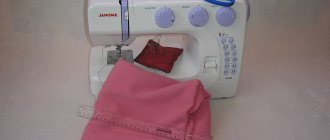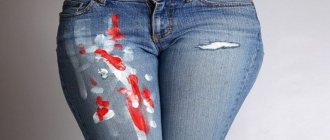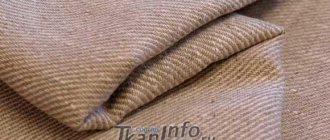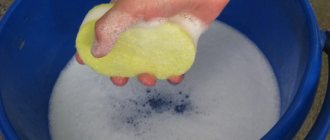Fabric Crease Rating
Almost all fabrics have the ability to wrinkle. Of course, the structure of synthetic fibers contributes to their recovery after the cessation of mechanical stress, but the flip side of this phenomenon is the lack of air exchange, moisture absorption and thermoregulation.
The structure of natural linen, cotton, silk and wool threads is not as uniform as synthesized materials. They have air-filled cavities that create comfort upon contact with the skin, but deform under load, thereby disrupting the smooth and beautiful appearance of the surface.
As a rule, dense and thick fabric wrinkles much less than thin and airy fabric. Much also depends on the method of weaving the threads - jacquard retains a smooth surface better than satin and satin, and they, in turn, are much inferior to simple linen texture. Thus, in order for clothes and bedding to look impeccable, you have to spend a lot of time and effort on ironing them. Therefore, the problem of what to do if the fabric is very wrinkled, and whether there are any means to correct this defect, concerns many people.
When is the bruise almost invisible?
Crease test
When purchasing a new item or material for its manufacture, you should always check how much it wrinkles. To do this, squeeze the edge of the fabric tightly in the palm of your hand and hold it for at least 10 seconds . If the resulting creases do not straighten out, you will need special means to maintain the product in decent shape.
To make the fabric wrinkle less, crush it yourself
Companies producing high-quality natural fabrics use selected raw materials with increased thread twist and high weaving technologies. In this case, a slight wrinkle in the suit looks very elegant and is a sign that its owner wears luxury, expensive items
Crash fabrics with specially industrially applied creases also look very stylish. This operation can also be done at home.
Stages of a “home crash”:
From such fabric you can sew a crinkled straight skirt or dress that will withstand several washes, after which the “home crash” operation can be repeated.
Proper fabric care
Viscose is practically never found in 100% fabric, but even in small proportions, it suffers from excess alkali. Therefore, it is important to choose the right detergent for delicate washing. The temperature at which viscose items will not lose their properties and shape is about 30°C.
When cleaning, you should also carefully read the instructions on the label. Since viscose fiber loses its strength when wet, and a mixed composition can give an unexpected result, a special approach must be taken to washing.
Machine washable
The “delicate” mode is used, without spinning. In this case, you should use special laundry bags and try to place fabrics of the same texture in the drum.
Handwash
This is the most gentle way to wash fabric. The product is placed in water with powder for half an hour, and then washed with light massage movements.
First of all, you must follow the instructions for the product. Most often, it contains comprehensive information regarding the temperature at which the thing does not deform.
Most often, a piece of fabric is washed before cutting in order to examine its properties in detail. Does the fabric lose color, texture, or shrinkage? This is an important stage in tailoring. Viscose fiber, in itself, holds color very well and does not lose its shape. Therefore, the determining factor will be the composition of the fabric - washing is required if there are natural fibers.
There are cases when clothes made of viscose with the addition of natural fibers stretch. In this case, you can return the items to their original appearance by increasing the temperature of the water when washing, then gently wring out the water and, laying the item on a towel, give it the desired appearance with your hands. If a product with an additive such as elastane has stretched, increasing the water temperature can only aggravate the problem.
Like any other natural fiber, cellulose has a porous structure. If you want to starch your underwear or shirt, the material allows you to do this. Everything happens in the same way as with natural fabrics - the product is placed in water with starch, dried, and ironed.
Whitening
To maintain the brilliant white color, viscose products can be periodically bleached. For this purpose, products with an oxygen bleaching component are used. Chlorine-containing bleaches will ruin the item.
Drying and ironing
After washing, carefully wring out the product, lay it on a towel, roll it up, and wring it out again. Next, the item needs to be laid out on a flat, horizontal surface, giving it its original shape. Ironing occurs on a damp cloth, from the inside; if the item is dry, then use wet gauze. It is not recommended to steam such things, nor to use a spray bottle - marks may remain. Temperature: “silk”.
Sometimes a product made of viscose wrinkles a lot. This disadvantage can be dealt with in two ways. Starch as described earlier. Or crash (from English crash-destroy). After washing, it is necessary to twist the wet product into a tight rope and leave to dry. Creases and bruises will add charm and a touch of charm.
This means it contains flax or wool. Not all of them can be treated with chemicals - various softening rinses. Unfortunately, some fabrics cannot be “tested” in advance and the defect becomes noticeable only the first time the product is used. In these cases, thin underwear is worn under the clothes or a lining of another material that is pleasant to the skin is sewn on.
Good old starch - and more
Ways to make clothes wrinkle less and bed linen sparkling clean have been known for several centuries - iron and starch.
When exposed to high temperatures, starch emulsion forms a hard but breathable film that not only looks beautiful, but also protects against dirt and also extends the life of the product. In addition, ironing starched material is much easier, methods for starching fabric.
For traditional starch, use a teaspoon or tablespoon of starch per liter of water. To prevent dark fabric from wrinkles, use a gelatin solution; It is also recommended for silk and viscose. However, for most modern women, washing by hand is an unaffordable waste of time, which only has to be done for particularly valuable items. For regular machine washing, there are many modern starching products available on the market, made on various bases.
A starch spray that is sprayed onto fabrics before ironing is very convenient to use . Its basis is a specially selected finishing material. Various sprays can contain both natural starch and synthetic resins, which create a long-lasting crease-resistant effect, as well as surfactants that make ironing easier, borax, which gives a beautiful shine, and other substances.
Source
Care
Washing and caring for wrinkle-resistant items depends on the type of fabric it is. The type of material, its characteristics and properties should be taken into account:
- Nylon (polyamide) can be cleaned in an automatic washing machine on a gentle cycle. The water temperature should be up to 40˚ C. Nylon products cannot be wrung out in a centrifuge and dried in a drying drum. Things made from such fabric should be hung to dry. If necessary, ironing can be done using the “Silk” program, without steam.
- Polyester is also machine washable. If the washing water is hot (above 40˚ C), wrinkles will appear on the fabric that are practically impossible to smooth out. White items are washed with ordinary washing powders, while colored items are washed with powders designed specifically for synthetics. Polyester dries very quickly and does not need ironing. If necessary, you can iron the fabric through damp gauze on the “Silk” program.
- Acetate and triacetate are composed of cellulose acetate. Any material containing acetate must be washed in the “Hand Wash” program at a temperature not exceeding 30˚ C. Fabric with triacetate can be washed in a normal mode, and the water temperature can be up to 70˚ C. Drying acetate and triacetate in a dryer is prohibited. Items made from such fabrics must be hung to dry. Triacetate can be ironed on the “Silk” or “Wool” program.
- Thick cotton. White fabric can be washed at a temperature of 95˚ C, colored fabric - at a maximum of 40, otherwise the colors will fade very quickly. Drying in a washing machine may cause significant shrinkage of the product. Cotton should be hung to dry, and it is better to iron slightly damp items by setting the iron to the “Wool” (for coated cotton material) or “Cotton” mode.
- Thick wool. The maximum water temperature when washing is 30˚ C. There should be a lot of water when washing; you should not rub or twist the fabric. Drying woolen products in special drying devices, in direct sunlight or on central heating radiators is strictly contraindicated. If necessary, ironing should be done on the “Wool” program through a damp cloth.
The composition of mixed fabrics is usually written on a label; it is extremely difficult to independently determine which fibers the material is woven from. It is necessary to know the composition in order to properly wash and care for an item.
To determine the predominant component, hold a piece of material about 5 cm long over the fire. Once the fabric catches fire, place it in a fireproof container and watch how the scrap burns:
- viscose, cotton and linen burn with flame and quickly, while the smell of burnt paper is felt;
- wool burns without flame with the presence of the smell of burnt hair;
- synthetics do not burn, but melt, turning into a solid ball.
Acetate fabrics can be dissolved with regular hairspray.
What to do if clothes are very wrinkled
When updating our wardrobe for summer, we all mostly give preference to natural fabrics. They have a number of undoubted advantages over synthetic ones: they perfectly absorb moisture and allow air to pass through, which gives a comfortable feeling while wearing. However, they also have one drawback, which sometimes brings a lot of inconvenience - great creasing. You can iron your dress perfectly in the morning, sit down on public transport and... it will lose its neat appearance. The thing is that threads made of linen, cotton and wool have a loose structure: their cavities are filled with air (due to which the skin “breathes” in them) and are easily deformed under load - the surface of the fabric loses its smoothness and evenness. What should you do to ensure that the item does not wrinkle and remains presentable throughout the day?
Rating of wrinkle-resistant fabrics
Before purchasing any item, check whether it is wrinkled. To do this, just squeeze the material tightly in your hand and hold it for 10 seconds. As a result, you will see which tissues are restored and which ones remain damaged. Note that linen, cotton and natural silk wrinkle the most. Viscose fabric - a staple - noticeably wrinkles (in order not to struggle with wrinkles, you can choose a variegated color of the fabric). Satin and chiffon may wrinkle, but to a lesser extent. But fabrics based on polyester or with a small addition of it are completely wrinkle-resistant.
How to iron linen correctly?
Linen items require special attention. Linen is a rather rigid natural fabric that can change during wear: over time it becomes softer. It takes a lot of sweat to iron a new outfit, but after a few washes everything will change.
Almost every housewife is confident that she irons her clothes correctly. But there are also things the ironing of which turns into hard labor. Not only are all the folds very difficult to smooth out, but they also wrinkle terribly. So is flax.
First, you should study the label with information about at what temperatures it is recommended to iron this wardrobe item.
Advice
Natural fabrics use higher temperatures than synthetic materials.
Step-by-step instruction
- The wet item must be removed; if it has already dried, moisten it.
- The temperature on the iron can be set to 200 degrees (unless otherwise indicated on the label).
- To prevent the fabric from shining after ironing, it must be ironed inside out. The use of wet gauze is also allowed.
- Linen is very difficult to iron to a perfectly smooth fabric, but small wrinkles will not spoil the overall picture.
- Linen items can be pre-sprayed with water. Then it will be much easier to smooth out all the wrinkles.
- It is better to iron all decorative elements on clothes (embroidery, beads, sequins) through gauze.
Linen clothing is very light and comfortable, so some difficulties with ironing will not prevent you from wearing your favorite item.
The most wrinkled fabrics
Let's start with the fact that all fabrics wrinkle: some more, some less, some are even specially processed to create a wrinkled effect. Synthetic fibers in the materials help to more easily restore the shape of things after any mechanical stress.
But natural fabrics are more prone to deformation, and to varying degrees:
Fine wool is also “friendly” with creases and is very difficult to part with.
Things that look harmonious with folds
There are a number of fabrics and things that, having a wrinkled appearance, do not look sloppy, but on the contrary, will highlight your style. But remember: this method is not suitable for all materials and cannot be used in every situation.
The following things can be done without ironing:
Whatever one may say, not ironing clothes is not an option. Often, unpleasant and deeply structured creases are discovered at the most inopportune time, when there is absolutely no way to thoroughly deal with them. And what to do if a very wrinkled fabric does not allow the ironing process? You may not know, but an iron is not the only assistant that can smooth out wrinkled fabric.
What to do if there is heavy soiling on viscose clothing?
What to do if severe stains have formed on viscose clothes? How to deal with them? In this case, you will have to resort to pre-soaking.
To do this, add warm water to a bowl of water and add hand wash detergent, which is optimal for this type of fabric. You will have to soak the dirty item for half an hour.
And only after that, proceed to the main wash: manually or in a washing machine, so that the contaminated item does not shrink.
Caring for clothes made from viscose fabric involves more than just careful washing. Even a properly washed item can be ruined by drying it on a radiator or in direct sunlight. After washing the product in a delicate cycle or by hand, it should be laid out horizontally or wrapped in a roll in a terry towel to absorb moisture. Then the clothes can be hung on plastic or wooden hangers.
It is necessary to exclude any alkaline and bleaching agents; it is advisable to prefer liquid detergent to powder. Dry cleaning allowed. Washing, drying, ironing and even wearing things should be done with caution. This will preserve the appearance of the product and extend its service life. We described in detail the properties of this material in the article “Artificial viscose”.
Read the label on how to properly wash wool clothes. Now do the opposite.
- For example, soak it in hot water for no more than 30 minutes. This may be 20 degrees more than what is written on the tag.
- Now rinse your clothes in cold water. You can even do it with ice.
- Take a large terry towel and wrap your clothes in it. This will remove excess moisture.
- It is forbidden to twist heavily woolen items.
- You need to dry it on a flat horizontal surface. It is very convenient to do this with a hairdryer, simultaneously giving the item the desired shape so that it does not stretch during the drying process.
Advice! If you need to make a wool hat a size or two smaller, then find a salad bowl of the required shape (round). Pull the hat over it and dry it with a hairdryer or leave it to dry naturally.
Woolen jackets and other items washed in a machine shrink greatly, but you cannot control the process. If your sweater is plain, you can set the “wool” mode and try it. And then dry as described above.
Whether a wool sweater was initially baggy due to the wrong size, or whether the sleeves and edges have stretched out over time, it can all be corrected. You can make your clothes shrink by performing a few simple manipulations with them:
- Wash woolen items in hot water at a maximum temperature of 20 °C higher than the recommended temperature. Baby laundry detergent is best used as a laundry detergent. It will help maintain the structure of the fibers. The spin speed should not be more than 500-600 rpm.
- After washing, the product should be rinsed in water at a temperature of 40 °C mixed with a capful of fabric softener.
- Then rinse it again in water at a temperature of 50 °C, but without additives.
- For woolen products, contrast rinsing is also relevant, in which immersion in hot water can be alternated with soaking in ice water.
We suggest you read How to reduce font size on your computer
What to do to prevent dress fabric from wrinkles
For evening walks in Prague, I bought a light summer dress in boho style. The trip around Europe was planned by bus, and in small hotels I had to run around looking for an iron, wasting precious time on ironing. After returning from the trip, I started thinking about what fabrics don’t wrinkle and what to do so that dresses don’t wrinkle so much.
What determines the wrinkleability of fabric?
First I studied the theory. It turns out that the property of creasing and wrinkling is inherent in most fabrics. But the homogeneous structure of synthetic fiber allows it to quickly restore its shape after mechanical stress. Fine? Yes, but in return we get the inability to absorb moisture and let air through.
Threads created by nature from silk, linen, cotton and wool are loose in structure. They have air-filled cavities, which, on the one hand, create comfort for our body. On the other hand, they deform under loads and the smoothness and evenness of the surface are disrupted.
Wrinkle or not
I spent the next part of the study in the fabric department, checking the creaseability of individual samples. To do this, I squeezed the edge of the material tightly in my palm, counted to 10, then evaluated the effect. On some fabrics, creases disappeared right before our eyes, while others formed deep folds.
Does natural silk wrinkle? Yes, this is one of the most wrinkle-resistant fabrics
Natural silk and linen turned out to be the clear leaders in the company of highly wrinkled fabrics.
The multifunctional and inexpensive viscose material - staple - wrinkles well and noticeably.
Thin cotton fabrics popular in hot weather (gauze, cambric, chiffon, muslin) also formed strong, numerous creases.
Satin, chiffon and Indian fabric - bengalin - were in no way inferior to competitors in the formation of folds and creases. But their edges are not as sharp as those of cotton fabrics.
At the next stand, my attention was drawn to a fabric with the strange name lyocell. It turned out that this mixed viscose fabric has all the properties of natural materials. Surprisingly, when I opened my fist, I saw that all the folds were slowly straightened out, the surface remained smooth.
Also, polyester-based fabrics turned out to be practically wrinkle-resistant. Knitted fabric, elastane, stretch polyester.
Ways to solve the problem
I figured out the creasing of fabrics. It's time to solve the next problem. What should I do to prevent the fabric on trousers, skirts, and shirts from becoming wrinkled? The third part turned out to be experimental. In practice, home and store-bought remedies were tested. The experiment involved a staple dress, a snow-white cambric shirt and six linen napkins.
Good old starch
The first remedy that came to my mind was starch. I diluted a tablespoon in a liter of cold water and soaked napkins in the solution. Then I ironed them with a hot iron, the process went without a hitch. A thin glossy film has formed on the surface of the napkins. Grandma said that this way the napkins not only look more beautiful, but also get dirty less and last longer. In her youth, bed linen, valances, and formal linen tablecloths were starched. Well, the result is good, the napkins passed the family dinner test.
Store-bought starch-based products
I washed the staple dress with liquid starch from EuroNOVA. I poured the measuring cup into the rinse compartment and started the machine. The slightly damp dress was easily ironed, the fabric looked natural after all the procedures, the folds lay in light waves. I was pleased with the result.
Starching spray
When I took a closer look at the starch products at the household chemicals store, it turned out that there was plenty to choose from. For a cambric shirt I chose Luxus starching spray. Sprayed it on my blouse. It did not leave any stains, did not stick to the sole of the iron, and left a pleasant impression. During wear, the shirt wrinkled, but at the same time it looked quite presentable.
Girls, wear clothes made from natural fabrics and look flawless.
Watch the video on how to fold clothes so they don't wrinkle.
Source
What makes denim and cotton coarse?
First of all, this comes from the water in which you wash the item. A trivial situation - the content of salts and chalk leads to the fact that natural fabric becomes very hard. The housewife can puzzle over this issue for a long time, changing the washing powder, but not achieving the desired effect. If your system has a centralized water supply, the cause may be salt deposits in the pipes. Well water may contain excess chalk. The solution to the problem is very simple - you need to install a cleaning and softening filter at the inlet of the washing machine, and the problem will disappear by itself.
Washing denim and cotton fabrics in water that is too hot will cause shrinkage as the fibers become compressed. Therefore, they should be washed at a temperature of no more than 50 °C. But if this unpleasant situation occurs, soak the item in cool water, wait for 15 minutes, dry, and then steam without touching the sole of the iron to the surface of the fabric. For this purpose it is better to use a steam generator.
Women have long learned to soften fabrics made from cotton fibers (and jeans are woven from them) with a soda solution. Add 3 tablespoons of baking soda to an 8-liter bowl of water, leave for 20 minutes and rinse with conditioner. You can twist with effort to soften the fibers. Place the denim items in the washing machine and put in special wash balls, turn on the intensive spin mode. This will help eliminate stiffness.
Removing pen marks and other stubborn stains from cotton
If a ballpoint pen stain appears on your favorite T-shirt or pants, do not rush to use a stain remover. There are several tips on how to remove pen marks from clothes, remove grease stains and other stains using products available at home.
Dish gel
Pour detergent onto the dirty area and rub it in your hands. Place clothes in the washing machine and wash at standard temperature. Dish gel will also help remove yellow stains. It is suitable for pure cotton, lycra, spandex, polyester, elastane.
Important! If the product fades, you should wash cotton in a washing machine at a lower temperature.
Warm alcohol
Use this remedy only as a last resort. This is a solvent that can remove not only stains, but also the color of fabric. First test its effect in a less visible place.
Expert opinion
Evgenia Taran
Dampen a cloth with slightly warm alcohol (use a cotton pad) and wipe the stained area. Wash it.
Alcohol will help remove greasy stains on a tablecloth, T-shirt, shirt, and remove old pen marks from white clothes.
Kerosene
You can remove tar stains from a jacket, sweater, trousers, or cotton sweater with kerosene. It is also suitable for black clothes. Wet the stain with kerosene and leave until the resin dissolves (this will take about 30 minutes). Wipe with purified gasoline, air, wash.
Salt
Salt effectively removes stubborn stains from cotton sweaters, knitted materials, knitwear, and synthetics.
Mix 1 tbsp. l. salt with juice of ½ lemon. Apply to problem areas. The stain takes at least 30 minutes to act on. Wash your clothes.
Boric acid
This acid penetrates deeply into the fabric, but at the same time does not damage the material. Therefore, it is suitable for cleaning knitted items, jumpers, pullovers, knitted dresses, T-shirts, pajamas. Boric acid also gently cleans synthetics. It can quickly remove iodine from fabric, remove old stains, and remove greasy stains.
Even synthetics will become soft
Many synthetic fabrics have properties that can be safely put on the same scale as natural ones. This is about technical characteristics. And if we talk about the possibilities of creating a unique design, then sometimes they have no equal. All girls now sew dresses and skirts from neoprene, they are at the peak of popularity.
Your wardrobe probably contains clothes made from materials that contain unnatural fibers:
One way or another, things made from synthetic fabrics have firmly entered our lives, so it is necessary to know how to handle them in order to ensure comfortable wearing.
To make this material soft, you need to use a conditioner and be sure to follow the rules indicated on the clothing label. Some housewives use vinegar or prepare the mixture themselves. But why resort to such methods if specialized products are sold in stores.
To make linen clothes pleasant to wear
Linen is a fabric from which people have been sewing clothes since time immemorial. Manufacturing technology involves the use of natural fibers, which are obtained in factories in several stages. Due to this, the fabric is soft. But sometimes you discover that the purchased item is itchy and unpleasant to wear.
Don't despair; the fibers may not have softened during one of the processing steps. You can make it softer at home. To do this, you should boil the thing that is pricking in water with the addition of a soap-soda solution. Please note that this can only be done if you are sure that the fabric is natural - synthetic fibers cannot withstand high temperatures and curl up.
Try steaming the item with a hot iron, after washing and rinsing the item using conditioner. Another effective option is to contact a tailor to have a lining sewn onto your product.
Cotton Bleaching
Sometimes even the best detergents cannot restore the whiteness of yellowed white clothes. Traditional methods will help to bleach fabric. They are also great for preventing yellowing and fading.
Expert opinion
Natalya Osadchaya
Cleaning company employee
All of these methods are extremely material friendly. Even the most expensive linen will remain undamaged, and stains and yellowing will disappear like a bad dream.
Before bleaching, be sure to remove any stuck-on dirt. For example, you can remove chewing gum from clothing by placing it in the freezer and then removing the gum with a knife.
Lemon
Lemon juice removes grease stains and sweat marks, restoring the shining white color of clothes, and gives a pleasant fresh smell.
You need:
- 250 ml fresh juice;
- 2 liters of water.
Add lemon juice to water. The solution is especially suitable for bleaching delicate fabrics. Wet the clothes and leave for 2 hours. Then wash with washing powder.
White vinegar
Vinegar can remove yellowness and graying well. Its whitening effect is often impossible to distinguish from the action of special products. Vinegar disinfects fabrics, eliminates any odors, and softens water.
You need:
- 250 ml vinegar;
- 2 liters of warm water.
Pour vinegar into water, stir. Soak the product in the solution for 8 hours. It’s okay if the effect of the solution lasts longer - you can leave your clothes wet overnight. Then wash it.
Eggshell
Adding an eggshell laundry bag to your washing machine will keep your fabrics snow-white. This method is most suitable for bleaching medical gowns.
Expert opinion
Evgenia Taran
If you need to wash your robe by hand, first soak it in water and lemon juice.
Citrus peel
This method combines aromatherapy and clothing bleaching.
You need:
- citrus fruit peel: orange, lemon or tangerine;
- 2 liters of water;
- 2 tbsp. l. hydrogen peroxide.
Place the peel in a pan of water and cook for a few minutes. Strain the boiling water and add hydrogen peroxide. Soak clothes in the solution for 2 hours. Then wash it.
Important! It is not recommended to use alkaline agents to bleach cotton. They can damage the fibers.










